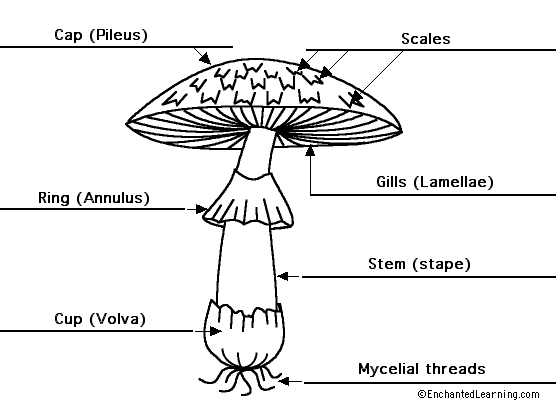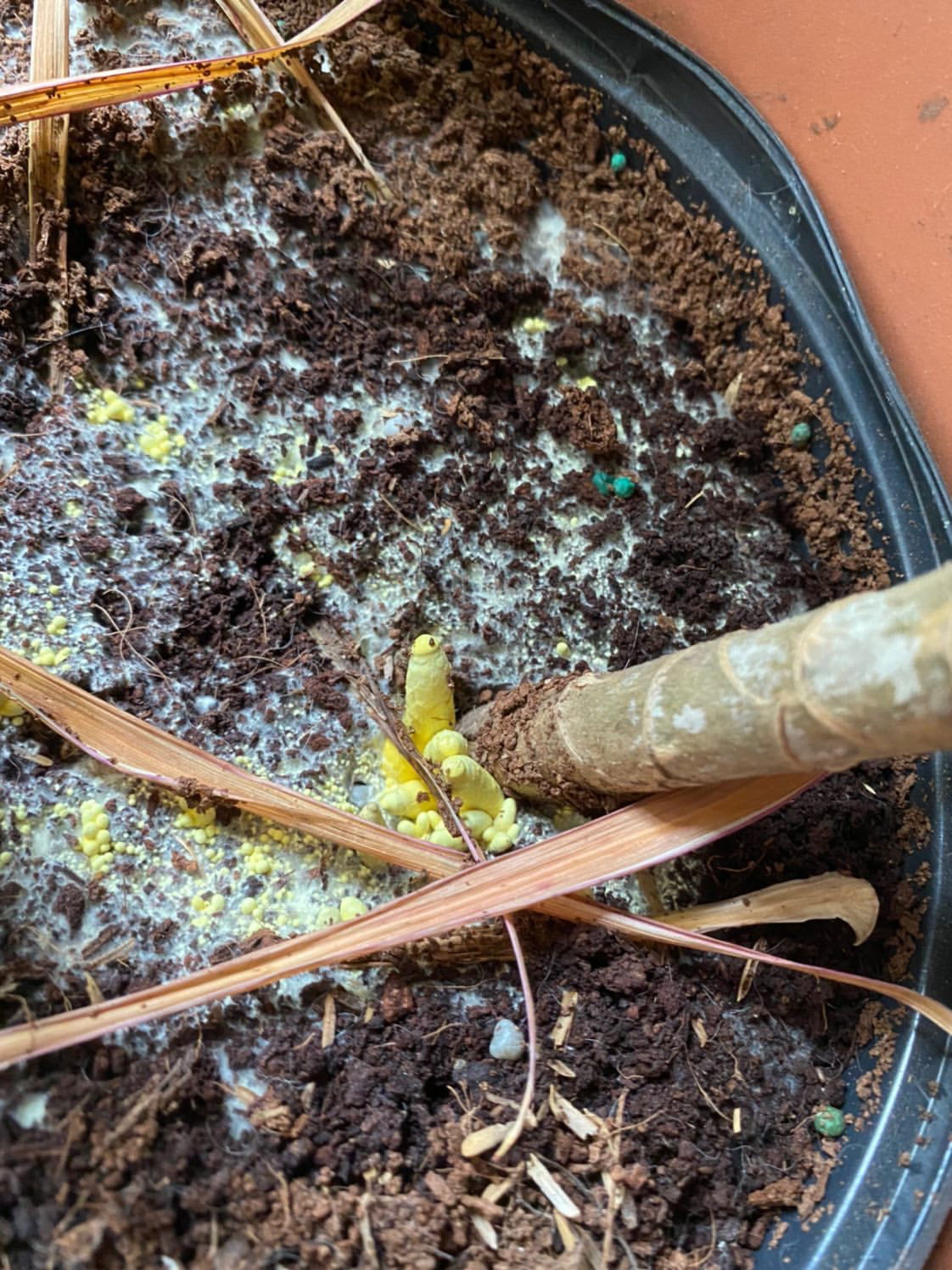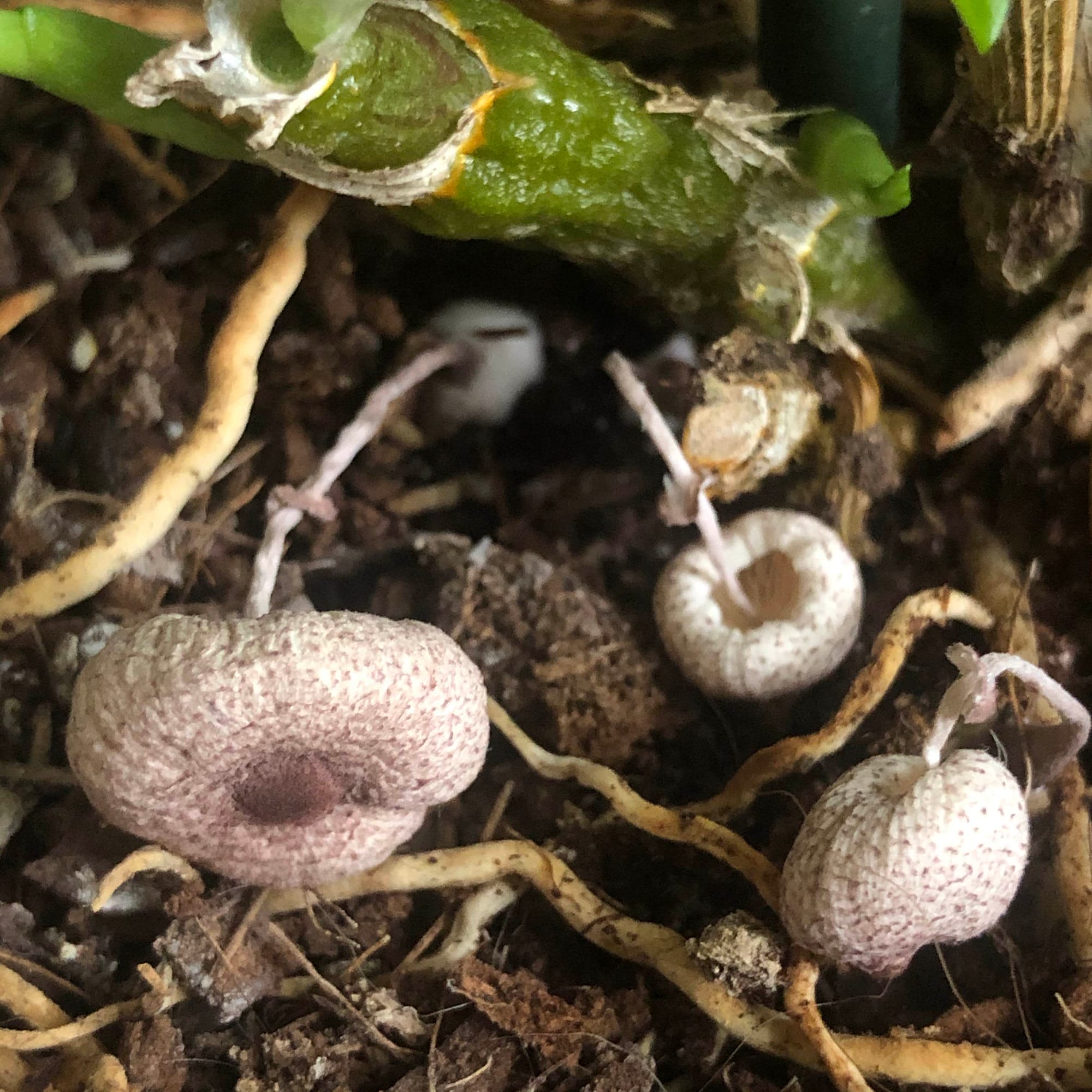Parasola plicatilis. The nickname for indoor mushrooms are 'Pot Plant Dapperling' or 'Pot Plant Parasols'.
Contents
- What are Mushrooms & are They Bad?
- Causes
- A Step-By-Step Guide to Remove Them!
- How to Prevent a Reoccurrence
Need the answer to a specific plant query? Book a 1-to-1 video call with Joe Bagley, the website's friendly author, to overcome and address your niggling problem! Available on iMessage, WhatsApp, Facebook Messenger & more.
 Once matured, the Gills will release the spores that can spread onto the surrounding compost below, or to new uncolonised areas via wind. Copyright: Enchanted Learning.
Once matured, the Gills will release the spores that can spread onto the surrounding compost below, or to new uncolonised areas via wind. Copyright: Enchanted Learning.
1. What are Soil Mushrooms & are They Bad?
Mushrooms are the 'fruits' of fungi, based of microscopic spores which can either be transported through the air or already-contaminated soils. It may take over two years before the dormant spores develop into mature mushrooms, with warm, moist locations speeding-up the this process greatly.
Most will develop on the organic matter within the soil's top layer. This includes bark segments, sphagnum peat, or even the fine soil grains. Although the presence of mushrooms aren't detrimental to the plant itself, some may be slightly toxic to pets and children so be sure to remove them as quickly as possible.
 Another common mushroom to appear in houseplant soil is Leucocoprinus birnbaumii.
Another common mushroom to appear in houseplant soil is Leucocoprinus birnbaumii.
 Another example of juvenile Leucocoprinus birnbaumii.
Another example of juvenile Leucocoprinus birnbaumii.
2. Causes
An infected batch of compost is the common culprit for an attack. Whether it was originally from the nursery or garden centre, or a recent transplant, indoor mushrooms can lay dormant in the soil for many months until the conditions are best suited for growth. When storing a bag of compost at home, be sure to keep it in a dry, dark shed or garage with the hole tightly sealed.
Over-watering and high humidity will speed up the process of development, as indoor mushrooms thrive in saturated, warm conditions.
A dark location that offers poor air circulation is another common culprit for an attack. Bathrooms and laundry rooms are the two hard-hit areas of the house as they'll provide a humid, shady location with little chance of fresh air.
 Mushrooms can easily spread via their microscopic spores, reproduced by the Gills on the 'cup's' underside. Once the mushrooms begin to wilt, they have completed their lifecycle and potentially have dropped hundreds of mature spores onto nearby soils.
Mushrooms can easily spread via their microscopic spores, reproduced by the Gills on the 'cup's' underside. Once the mushrooms begin to wilt, they have completed their lifecycle and potentially have dropped hundreds of mature spores onto nearby soils.
3. A Step-By-Step Guide
- Take the plant out of its pot and remove the top few inches of the soil. It's important to the LOOSE compost on top as this is where the majority of the spores will lay dormant. Remember not to pull soil from the roots as this will cause permanent damage and even plant death in some cases.
- Wash the container or pot to remove any ungerminated spores that may lay on the surface. There are several products you can use; however, ukhouseplants would recommend either warm soapy water or even Hydrogen Peroxide for total cleanliness.
- Replace the top 25% or two inches of the soil for a fresh batch of the appropriate potting mix. If you're unsure of which to use, send us a message and we'll point you in the right direction. Remember, we now sell top-quality potting mixes for all houseplants, which include FREE Delivery and a resealable bag to keep it fresh for over 12 months!
- It's essential to remove the large lumps of organic matter from the new potting mix (coconut coir or bark, etc.) as they'll hold excess moisture that may harbour a breeding ground.
- The final step is to consider its location and your watering habits. A setting that offers high humidity, poor air circulation and low light should be avoided, especially if you're an over-waterer.
Additional Information
In some cases, the mushrooms may return. More severe cases will require two or three compost-changes to deplete the case from spreading further. As long as you don't over-touch the root system, or pull compost from the soil, there won't be any risk of permanent damage. You can also thinly spray Fungicide onto the new compost's top, which will further reduce the chance of a re-emergence. Repeat this in fourteen days, before allowing a period of three months before deeming the eradication successful.
As mentioned before, some mushrooms will take over two years to develop. Mushrooms are NOT harmful to the actual plant, which means you shouldn't panic over the unwanted visitor. If you see it, remove it - before the 'Gills' become mature and release hundreds of spores!
4. How to Prevent a Reoccurrence
First things first; reduce the frequency of waters if it's in a dark location. In some cases, but not all, mould or mushrooms can still develop on dry soil, but usually is caused by poor soil or low light. The relationship between the frequency of irrigations and the light levels is significant. If you've got a plant in a shady setting with high humidity, you must allow the top few inches to dry out in between waters. This is because the combination of no natural lighting and overly saturated soil will significantly increase spore germination.
Poorly stored bags of compost use never be used for houseplants. When there's an open hole in the sack, moisture can be absorbed into the soil which will be a breeding ground for nasties to develop. If you've got leftover soil, be sure to keep it in a dry, dark environment with the hole sealed fully.
Regularly check for any signs of fungus or mushrooms in the plant's soil - even if it's just a small portion becomes moulded, be sure to remove the whole layer for a fresh batch. You can never be too safe with an infestation of pests or diseases, especially if you have them in close proximity to one another!
Book a 1-to-1 Consultation with THE HOUSEPLANT DOCTOR™
Need realtime advice for your houseplants & mushroom growth? Book a video or message consultation with expert Joe Bagley, THE HOUSEPLANT DOCTOR™ (author or ukhouseplants.com). Choose between a ten or thirty-minute session & a platform of your choice (WhatsApp, FaceTime, Facebook Messenger or Zoom). Ask unlimited questions in one session, including queries on your dying/challenging plants, pests eradication, terrariums, repotting advice & everything in between! Available worldwide.